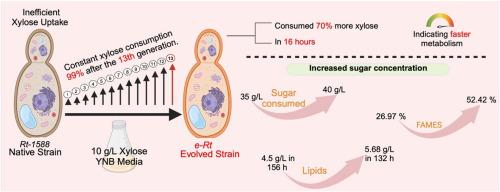Adaptive laboratory evolution (ALE) as a tool to ameliorate xylose consumption in Rhodosporidium toruloides-1588
IF 5.8
2区 生物学
Q1 AGRICULTURAL ENGINEERING
引用次数: 0
Abstract
Rhodosporidium toruloides, an oleaginous yeast, is extensively studied for biofuel production due to its ability to accumulate lipids. However, its industrial application is constrained by its inefficiency in xylose uptake and utilization, particularly when cultivated on lignocellulosic hydrolysates, where xylose is the second most abundant sugar. To address this challenge, R. toruloides-1588 was evolved using Adaptive Laboratory Evolution (ALE) as a tool in minimal media with xylose as the sole carbon source to enhance its utilization. The evolved strain achieved 99 % xylose consumption by the 13th generation, with a 70 % increase in xylose uptake within 16 h compared to the native strain. When cultivated in yeast malt synthetic media, the adapted strain showed a 15 % increase in xylose consumption and a 23.40 % increase in lipid accumulation with a two-fold increase in oleic acid content (52.42 %). Further, in bench-scale-up studies (1L) using xylose-wood hydrolysate (C5-wood hydrolysate) as a culture media, the evolved strain showed a maximum lipid accumulation of 23.42 g/L at 156 h, representing an 18.35 % increase compared to the native strain (19.79 g/L) under the same conditions. These results highlighted the effectiveness of adaptive laboratory evolution in enhancing xylose uptake by R. toruloides-1588. This led to an improved growth, sugar co-utilization, and lipid accumulation on complex substrates for sustainable biofuel production.

适应性实验室进化(ALE)作为改善环形红孢子虫-1588木糖消耗的工具
toruloides红孢子虫是一种产油酵母,由于其积累脂质的能力,被广泛研究用于生物燃料生产。然而,它的工业应用受到木糖吸收和利用效率低下的限制,特别是在木质纤维素水解物上培养时,木糖是第二丰富的糖。为了解决这一挑战,以木糖为唯一碳源,以适应性实验室进化(ALE)为工具,在最小培养基中对toruloides-1588进行了进化,以提高其利用率。进化菌株在第13代时达到99%的木糖消耗,与本地菌株相比,16小时内木糖吸收量增加了70%。在酵母麦芽合成培养基中培养时,适应菌株木糖消耗量增加15%,脂质积累增加23.40%,油酸含量增加2倍(52.42%)。此外,在使用木糖-木材水解物(c5 -木材水解物)作为培养基的实验放大研究(1L)中,进化菌株在156 h时的最大脂质积累量为23.42 g/L,与相同条件下的天然菌株(19.79 g/L)相比,增加了18.35%。这些结果强调了适应性实验室进化在促进toruloides-1588木糖吸收方面的有效性。这导致了可持续生物燃料生产的复杂底物上的生长,糖的共同利用和脂质积累的改善。
本文章由计算机程序翻译,如有差异,请以英文原文为准。
求助全文
约1分钟内获得全文
求助全文
来源期刊

Biomass & Bioenergy
工程技术-能源与燃料
CiteScore
11.50
自引率
3.30%
发文量
258
审稿时长
60 days
期刊介绍:
Biomass & Bioenergy is an international journal publishing original research papers and short communications, review articles and case studies on biological resources, chemical and biological processes, and biomass products for new renewable sources of energy and materials.
The scope of the journal extends to the environmental, management and economic aspects of biomass and bioenergy.
Key areas covered by the journal:
• Biomass: sources, energy crop production processes, genetic improvements, composition. Please note that research on these biomass subjects must be linked directly to bioenergy generation.
• Biological Residues: residues/rests from agricultural production, forestry and plantations (palm, sugar etc), processing industries, and municipal sources (MSW). Papers on the use of biomass residues through innovative processes/technological novelty and/or consideration of feedstock/system sustainability (or unsustainability) are welcomed. However waste treatment processes and pollution control or mitigation which are only tangentially related to bioenergy are not in the scope of the journal, as they are more suited to publications in the environmental arena. Papers that describe conventional waste streams (ie well described in existing literature) that do not empirically address ''new'' added value from the process are not suitable for submission to the journal.
• Bioenergy Processes: fermentations, thermochemical conversions, liquid and gaseous fuels, and petrochemical substitutes
• Bioenergy Utilization: direct combustion, gasification, electricity production, chemical processes, and by-product remediation
• Biomass and the Environment: carbon cycle, the net energy efficiency of bioenergy systems, assessment of sustainability, and biodiversity issues.
 求助内容:
求助内容: 应助结果提醒方式:
应助结果提醒方式:


